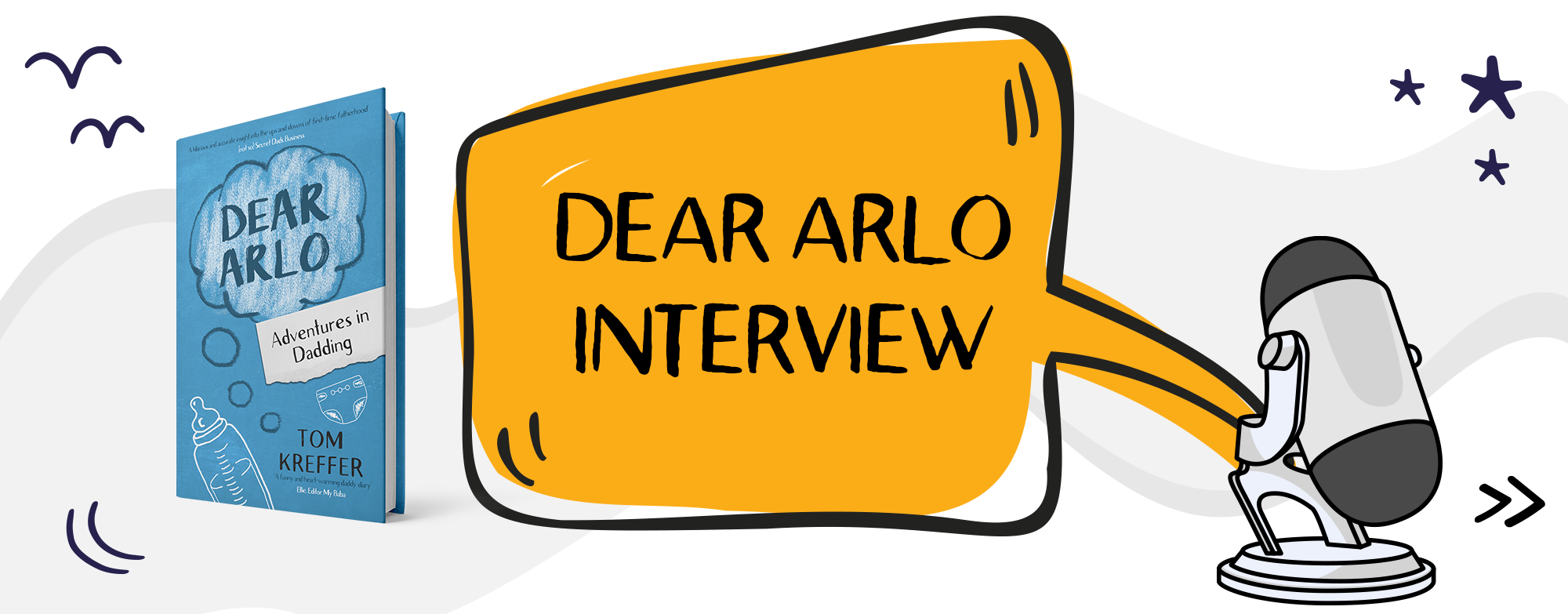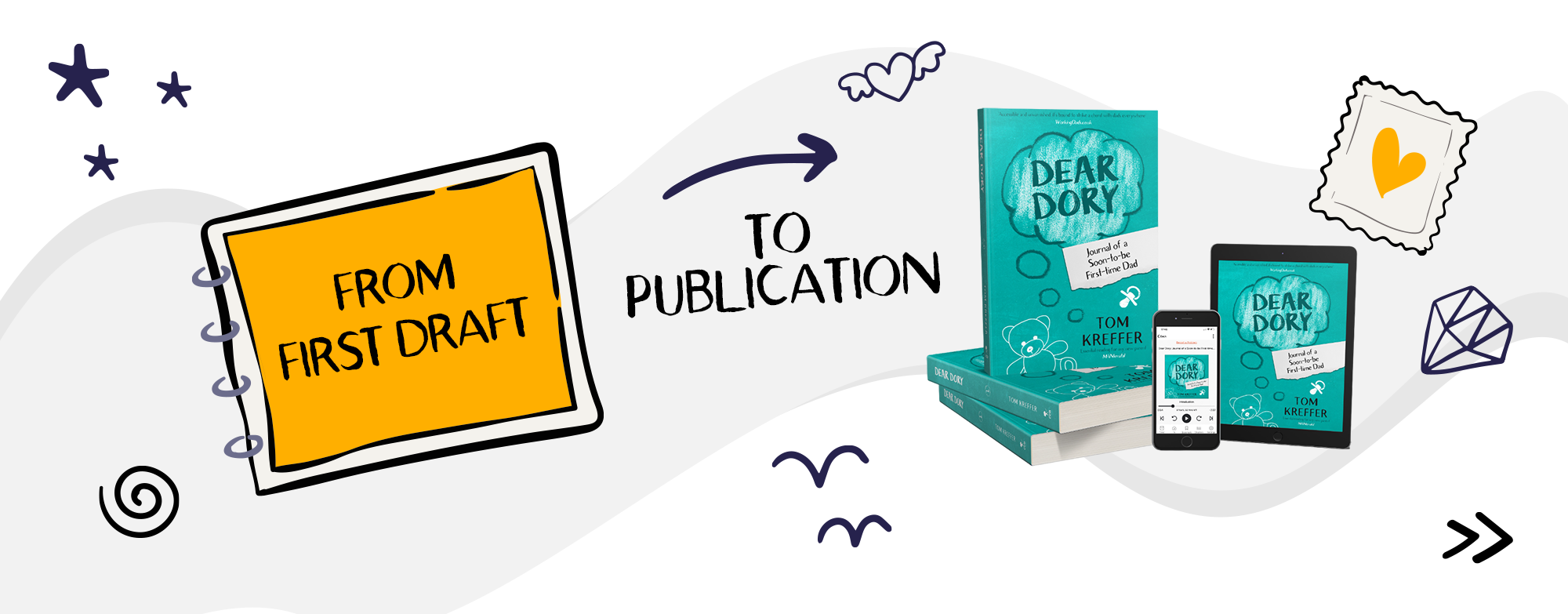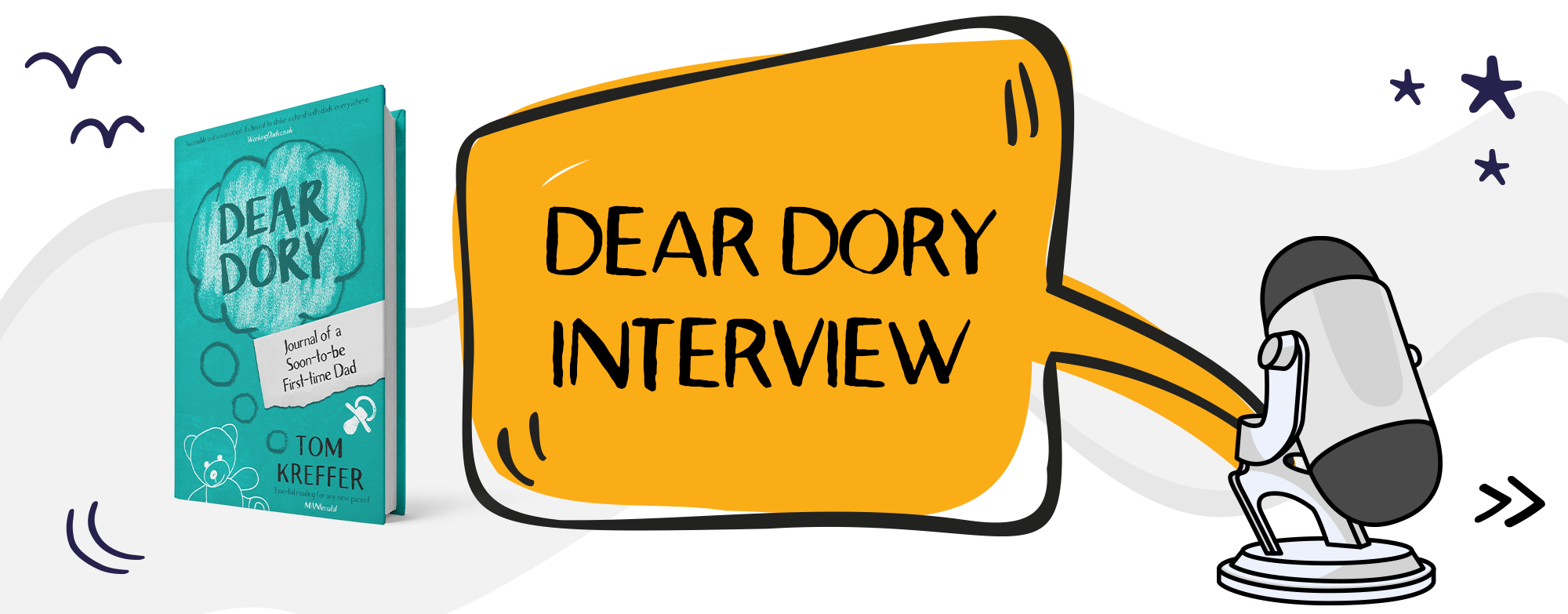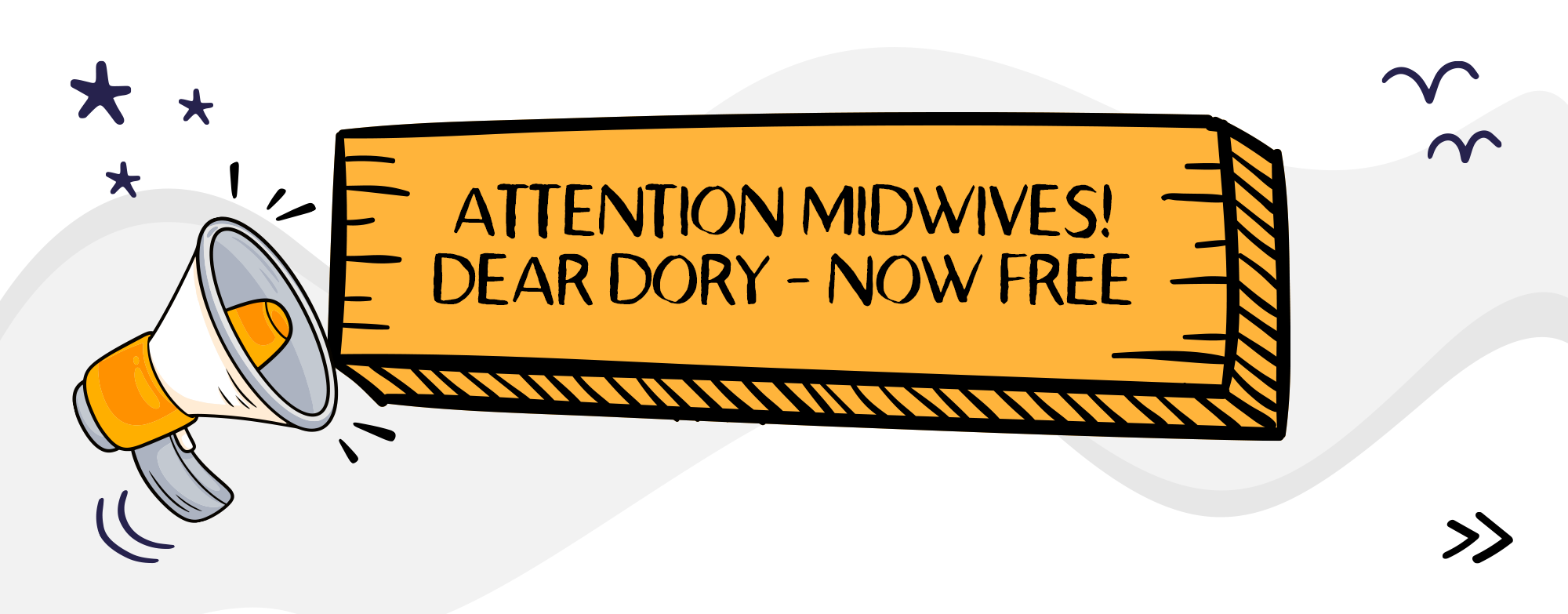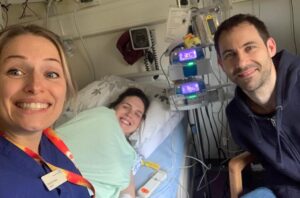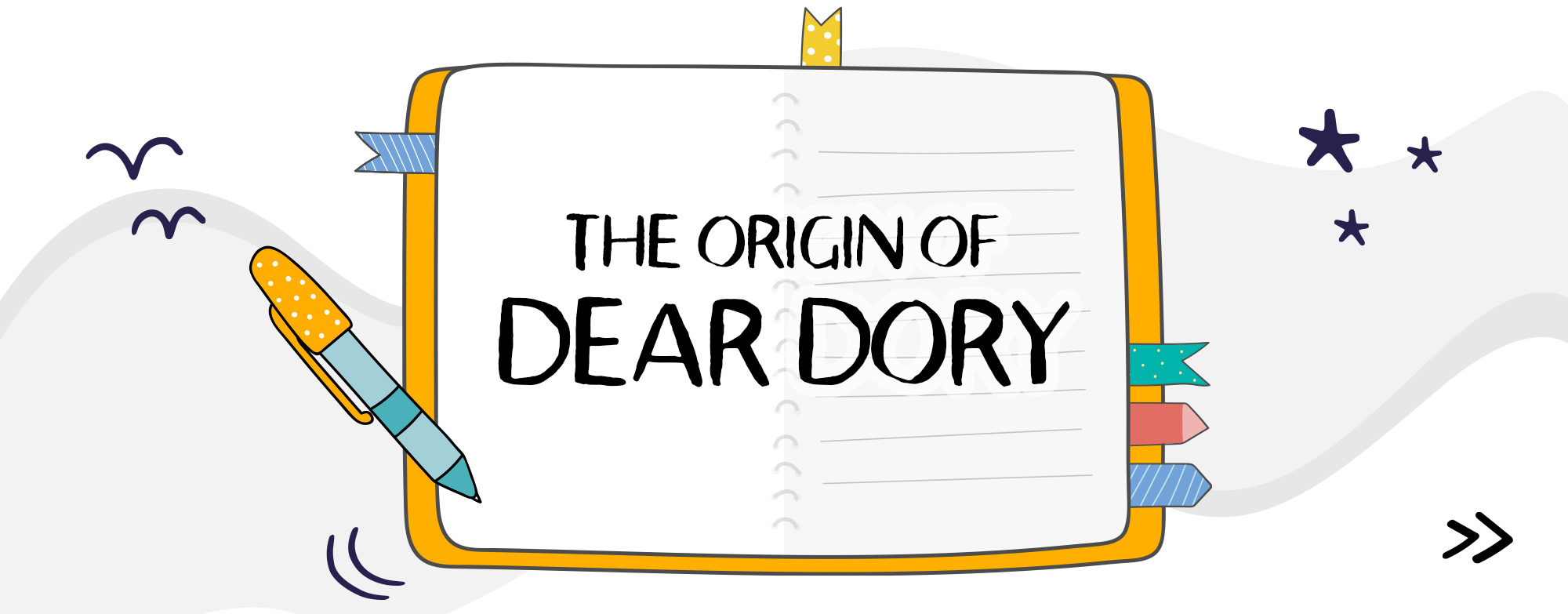Interview with author Tom Kreffer, discussing his book, Dear Arlo: Adventures in Dadding
ABOUT THE AUTHOR
Tom Kreffer is the author of the Adventures in Dadding book series, memoirs covering his son’s early childhood. He loves Star Wars and Marvel movies, and he has a degree in film and television that he firmly believes to be worth less than a second-hand toothbrush.LEARN MORE
Dear Dory Creative Process – Part 5: Ten Months Later
Welcome to Part 5, the final post in the ‘Dear Dory Creative Process’ series. You can read Part 1, Part 2, Part 3 and Part 4 here.
I wanted to end this series by detailing the two biggest lessons I learnt from publishing my first book.
Lesson number one is:
Writing is essentially two full-time jobs
It takes a tremendous amount of effort to produce a book of high quality – and that’s just my personal contribution, without mentioning the work of editors and test readers.
But the writing is only half of the gig. The other half is marketing. And it takes more forms than I could possibly have expected: book covers, interior formatting, website, social media presence, email marketing and newsletters, press releases, reader reviews, editorial reviews, book promotions, networking, guest blog articles, book trailers, content marketing, podcast interviews, interaction with readers, working with businesses to create mutually beneficial partnerships.
I suspect there are a lot more areas I haven’t discovered or got round to tackling yet that should be included on this list.
Book covers
Let’s take one aspect of marketing: cover design. I’ll give you an insight into the process with Dear Dory. First, I hired a creative agency. They sent me over two concepts. I wasn’t crazy about either of them, but with a tweak to one of the visions, we had something we could use as a foundation and build on.
Next, we went through several iterations, which included hiring a graphic designer to create some artwork. This took time and money. I was sent several different colour schemes for the cover, which I then sent to as many people as possible, asking them to vote for their favourite. I then selected the option that had the most votes.
Fortunately, there was a clear winner.
The whole process spanned weeks and involved hours of work from many different people. And that describes just one item on the long list of marketing areas that an author should be considering – especially a brand-new author whom no one has heard of.
Lesson number two is:
Listen to your gut
Sticking with the book cover, even after all of that work I hated it. Actually, I hated the e-book cover. The hardback and paperback versions looked OK, but overall I was never awed. I can’t explain why; something about it just never sat well with me. It was the same with the interior formatting (carried out by the same company). I just thought the book looked a bit cheap and amateurish – as if I had done it all myself.
I was disappointed, because I was reaching that milestone: the great moment in an author’s career when they get to hold a physical copy of their first book for the first time. But I allowed the design agency to override my gut instinct and talk me out of making any more changes – which was a big mistake.
The lesson I learnt is that I need to rely on my gut. It’s a bit like deciding what to do with test-reader feedback. I know that pleasing everyone is a pipe dream, and so I have to rely on my gut instinct to tell me which bits I need to rewrite, which bits I need to delete and which bits I need to leave well alone.
Even the Harry Potter series has its critics.
Ultimately, I get the final say on everything. It’s creatively liberating, but it’s also a lot of responsibility, and it’s mentally taxing and draining at times.
This is something I didn’t expect when writing my first book.
But every cloud …
After Dear Dory came out, I was able to network with other authors, and I joined a couple of fantastic Facebook groups. There, I was able to get recommendations for another design agency that I could work with.
The new agency designed a much better cover for my second book and redesigned Dear Dory, maintaining the original conceptual theme but improving on the quality and execution. It was a costly way to correct a mistake, but I was all too happy to pay the price. I love the new book covers, and I feel the branding is much better aligned to the type of books I write (in this series, at least).
It’s fair to say that I’ve spent most of 2021 either correcting mistakes I made or learning more about book marketing. But I’m OK with that. I’m happy that I’m learning and improving on aspects of being an author that aren’t just about the writing element, though that’s still my number one priority.
I’m optimistic about the future. I will continue to pour my soul into my book projects, making them the best they can be. There is nothing more rewarding than having a reader contact me and tell me how much fun they had reading Dear Dory or how impactful it was because they’re going through similar experiences.
The words of encouragement I get are fuel. They help me get up early in the morning and write, and they help me weather all my ignored emails pitching to bloggers and influencers. They help me maintain the highest standards. They keep me going.
I’ll end this series by saying thank you to all of you who have checked out Dear Dory or any of my other books, and to any future reader. I can’t tell you how much your support means to me.
And to every other writer out there in the universe, just keep swimming. Humanity craves stories, and there will always be a demand for them, so write them to the best of your ability and continue learning and honing your craft. Keep going!
Don't Forget...
Enter your email address below to sign up for the Lessons in Dadding Newsletter, featuring tried, tested and timeless wisdom to help dads become better at dadding.
No spam. Only lessons, tips and resources on becoming a better parent. You can view my privacy policy here.ABOUT THE AUTHOR
Tom Kreffer is the author of the Adventures in Dadding book series, memoirs covering his son’s early childhood. He loves Star Wars and Marvel movies, and he has a degree in film and television that he firmly believes to be worth less than a second-hand toothbrush.LEARN MORE
Dear Dory Creative Process – Part 4: From First Draft To Publication
Welcome to Part 4 of the ‘Dear Dory Creative Process’. You can read Part 1 here, Part 2 here and Part 3 here.
Once I completed the first draft of Dear Dory (early December 2019), I switched Grammarly on and was rewarded with a list of over 5,000 errors and suggested improvements. Naturally, the next thing I did was shut my laptop and forget about it until after Christmas.
But come January, it was time to get to work.
I often hear writers say that the first draft is the hardest. Not for me. Not for my first book, at least. Drafts two and three were brutal. They each took me a month to complete and involved about four hours of deep work each day. That’s alongside looking after a newborn baby with my partner while also reading and learning as much as I could about the craft of writing and publishing.
Rewriting is like sculpting a block of stone. You circle your block ever so slowly, lightly tapping and chipping away at the rock – slowly shaping it into something that’s appealing to the eye, something that your audience will want to appreciate in its entirety.
I hired a structural editor and two fantastic copy editors. While helping me get the book to the proper professional standards, their combined support also taught me a lot about storytelling.
Next, I needed to test out the material with readers, preferably readers who were new(ish) parents able to relate to the story of pregnancy but who didn’t know me, so as to limit any unconscious bias. I messaged all my mates and asked them in turn to message all their friends who were parents and rustle up some test readers for me.
I was astonished by how valuable and insightful a fresh pair of eyes is. While I expected this with professional editors who work with authors and publishers for a living, I didn’t expect to receive so many valuable suggestions and improvements from other readers.
I learnt which jokes worked and which didn’t, which areas were boring, which chapters weren’t working and which areas were good but could be even better. And so the book became all the better because of the keen insights I received from others.
All in all, Dear Dory went through fourteen drafts.
I also designed a shockingly bad website (it has since been updated) to help with the launch.
I then began pitching to as many bloggers and parenthood networks as possible. Ninety-nine per cent of my emails were ignored. I had no social media presence, and Dear Dory wasn’t out yet, so I had no online proof that it was any good – no reviews, etc. But I wasn’t totally ignored. The parenting website My Baba were kind enough to feature Dear Dory in their Christmas recommendations guide. They also let me write an article for their website (Top 10 Tips For New Dads which you can read here).
I secured press coverage; a local paper wrote a piece. Bernie Keith from BBC Radio Northampton invited me on his show and said some wonderful things about the book.
On 30 October 2020, Dear Dory: Journal of a Soon-to-be Dad went on sale. I was now officially an author with my first title available for purchase.
The next thing to do was to sit back and wait to see what came next.
Don't Forget...
Enter your email address below to sign up for the Lessons in Dadding Newsletter, featuring tried, tested and timeless wisdom to help dads become better at dadding.
No spam. Only lessons, tips and resources on becoming a better parent. You can view my privacy policy here.ABOUT THE AUTHOR
Tom Kreffer is the author of the Adventures in Dadding book series, memoirs covering his son’s early childhood. He loves Star Wars and Marvel movies, and he has a degree in film and television that he firmly believes to be worth less than a second-hand toothbrush.LEARN MORE
Interview with Tom Kreffer, author of Dear Dory
When did you decide to write Dear Dory?
Truthfully, I didn’t; it was a complete fluke. Doctors told my partner and me that it would be extremely unlikely for us to conceive naturally, owing to some fertility complications with my partner. We were on the waiting list for IVF when, out of nowhere, she fell pregnant. But I’d already made up my mind that unless we got lucky with IVF, we would never have children unless we adopted, so on the day we found out – let me tell you, the emotional response I felt was the most intense feeling I’ve ever experienced.
And a few hours after my partner took the pregnancy test, I began writing some notes in my journal about how I found out I was going to be a Dad, and what that felt like. I ended up doing this every day for about a week, at which point I decided I would keep up with the practice all through the pregnancy.
But then, after ten days, I realised I had 5,000 words, and that I was averaging about 500 words a day. I calculated that if I continued at that pace every day, right up to my partner’s due date, I’d have approximately 122,000 words, and that would be enough for a book. But I assumed it would be a personal book project for my family and me. I never envisioned publishing it.
In that case, when did you decide to publish it?
I think I was about eight weeks into the writing when I started to wonder if others would find what I had written valuable, or at least entertaining. I found the whole pregnancy journey to be nuts, and I underestimated how much of a big deal it is. Starting a family is something most people experience – I guess that fact must have created a false narrative in my mind of what pregnancy was like. I was unprepared for the massive identify shift that happens when you become a parent. And that shift begins as soon as you see those two lines on a pregnancy test – everything changes, and there is no looking back.
I researched pregnancy books for Dads and found that there wasn’t much out there, especially in the format I was writing in – daily journal entries. Although I’d adopted the journal format by fluke rather than design, I thought it worked well, and I felt that a book written in that style would be an interesting and different approach to describing pregnancy. And, adding in the fact that it’s told from the Dad’s perspective, I thought I had something unique that others would find valuable. I began thinking about this as a project that could engage and interest many people.
What do you hope readers will get out of Dear Dory?
I didn’t write Dear Dory as a guidebook. That said, I experienced many of the things that new soon-to-be parents go through: fear, anxiety, excitement, financial worries, the challenge of making working arrangements for when the baby arrives, deciding on the Dad’s role during labour. I wrote about it all, and I think people will find value in that. Readers will see how I worked through all of those challenges, learning important lessons along the way, and I hope that my experiences will be helpful to others.
Broadly speaking, men aren’t exactly renowned for being vocal about their emotions, so Mums in particular will, I hope, find these insights from a Dad’s point of view revealing in a way that is perhaps new to them.
If you’re a parent and you’ve already been through the journey of pregnancy, then you’ll probably be able to relate to my experiences in the book. A lot of my early readers were parents already and nearly all of them commented on how Dear Dory reminded them of their own experiences – in a good way.
Finally, I really hope people get a laugh out of reading Dear Dory. My experience was scary at times, but it had so many standout moments that made me laugh, and my partner’s behaviour as a pregnant woman was incredibly funny, which made the writing a lot more entertaining; I certainly don’t go easy on her. On the day she finished reading it, I was relieved to learn that she wouldn’t be leaving me.
So, even if you don’t learn a single thing about pregnancy or parenting – you should have fun. Dear Dory is a non-fiction book, but I would say that it also reads like good fiction, which is something that works in the book’s favour, I think.
What do you hope to get out of Dear Dory?
Initially, I just wanted to use my journal to help me work through the hundreds of questions about pregnancy and parenting that ran through my mind. It certainly did that. Now that it’s published, I just want readers to connect with it and enjoy it – and I want it to help people.
This is perhaps a bit ambitious: there are a few ‘pregnancy classics’ that soon-to-be mums are encouraged to read, such as What to Expect When You’re Expecting and The Unmumsy Mum. I’d love it if Dear Dory were to become one of those classics for parents. As I said, it’s ambitious, but why not? Aim high, right?
Tell me about your writing process.
All the entries were written to Dory, which was the name we temporarily assigned the baby. Having my unborn child to write to coaxed everything I was experiencing out on to the page in the most revealing way. I didn’t hold back – I couldn’t, even if I had wanted to. It’s an interesting way to write. If I had written it to myself, the book wouldn’t have been as good.
In terms of writing, the challenge was to produce something every day. I think I knew that not all of it would make the final cut, even though I’d never written a book before or worked with editors. So I wrote every day and ensured that 99 per cent of the content somehow related to pregnancy, to babies and to parenting.
I didn’t structure anything; every day I’d wake up and wonder what would happen for me to write about. It was quite liberating, in a way. That said, pregnancy defines the structure for you perfectly. You have the start, with the big incident that kicks the story off – in my case, the pregnancy test – followed by three acts, each one a trimester of the pregnancy, and then you have a big dramatic conclusion with the labour. So when I say I didn’t structure anything, I didn’t have to; it was naturally laid out in front of me.
Will you continue with the format now that the baby is here?
Definitely. Because these books are daily journal entries, I had to begin book two the day after I’d finished the first draft of Dear Dory. I was rewriting Dear Dory and getting it ready for publication while writing the sequel, which is hardly ideal when you have a newborn baby and a day job, but I recognised that the fluke of starting Dear Dory had created an opportunity for me and possibly the start of a writing career, so I threw all my chips in and got to work. In fact, I’ve nearly finished the first draft of book two and I’m committed to writing book three in the series. Who knows what will happen if they take off? I love the format, and I love the response to Dear Dory that I’ve had from readers – it’s motivating me to keep typing away.
Any other writing projects on the horizon?
I’ve got tons in the pipeline. Honestly, I spend just as much time on Evernote writing ideas and notes for other projects as I do on the Dad journals. I really want to tackle fiction. I have an idea for a big action-adventure sci-fi series that I want to write, and now that I’ve cut my teeth with Dear Dory, I feel ready for the challenge. It’s influenced by some of my favourite fiction writers, like Matthew Reilly, Michael Crichton and JK Rowling. The scale of this thing is huge.
I also wrote a children’s short story that I included in an early draft of Dear Dory, but I cut it because it didn’t fit structurally within the rest of the journal entries. But I got great feedback from my editors and from people who read earlier drafts, so it’s something I want to return to in future.
Maybe I can release it on my blog or write more stories and publish it as part of an anthology. It’s about a plate spinner named Clay who lives on the planet Salva (everything is based on items you’d find in a kitchen). The people of Salva have to spin plates to create elbow grease because it’s elbow grease that makes the planet go round. The story employs a lot of crazy but fun imagery to illustrate some serious life lessons, such as the importance of challenging assumptions and forging your path in life rather than following the crowd.
Then there are my film projects. I spent my 20s writing screenplays, and while they were mostly terrible there are a few ideas I’m really attached to that I think are good; they just need a polished script. One of them is about a man who clones his dead wife so he can find out who killed her. Pretty cool, right?
Now I just need to find a way to add a few more hours to the day while maintaining 110 per cent productivity and I can get round to some of them. And of course I still have to show up each day for the Dad gig, which, I might add, is my all-time favourite responsibility. I love it.
Sounds like you’re a very busy man. Where can people find you and say hello?
My website: www.tomkreffer.com Twitter:@TKreffer Instagram – @tom_kreffer Facebook – @OfficalTomKreffer
Anything else you want to say?
Only that I hope readers enjoy Dear Dory; please let me know what you think.
Also, it won’t be long before I’m back with book two, so if you do enjoy Dear Dory, there’s plenty more to come.
Don't Forget...
Enter your email address below to sign up for the Lessons in Dadding Newsletter, featuring tried, tested and timeless wisdom to help dads become better at dadding.
No spam. Only lessons, tips and resources on becoming a better parent. You can view my privacy policy here.ABOUT THE AUTHOR
Tom Kreffer is the author of the Adventures in Dadding book series, memoirs covering his son’s early childhood. He loves Star Wars and Marvel movies, and he has a degree in film and television that he firmly believes to be worth less than a second-hand toothbrush.LEARN MORE
I have decided to make Dear Dory: Journal of a Soon-to-be First-time Dad free for all midwives around the globe.
Don't know what Dear Dory is about? I'll tell you. It's the emotionally profound story of pregnancy, as told through the eyes of an expectant first-time father and his journal. Check out the reviews on Amazon.
I was astounded by the level of care that my partner received when she was in hospital giving birth. All the midwives we dealt with were wonderful. So I thought this would be a nice way to say thanks.
I had always planned to do this; I just hadn’t got round to setting it up until now.
If you’re a midwife and you would like to read (or listen to) Dear Dory without paying a penny – look no further.
CLICK HERE to subscribe and claim your free copy
Remember! It doesn't matter where in the world you live. All you need is a valid email address so you can prove you are a midwife, and Dear Dory is yours for free – FOREVER!
Don't Forget...
Enter your email address below to sign up for the Lessons in Dadding Newsletter, featuring tried, tested and timeless wisdom to help dads become better at dadding.
No spam. Only lessons, tips and resources on becoming a better parent. You can view my privacy policy here.ABOUT THE AUTHOR
Tom Kreffer is the author of the Adventures in Dadding book series, memoirs covering his son’s early childhood. He loves Star Wars and Marvel movies, and he has a degree in film and television that he firmly believes to be worth less than a second-hand toothbrush.LEARN MORE
Dear Dory Creative Process – Part 3: The First Draft
Welcome to Part 3 of ‘The Dear Dory Creative Process’. You can read Part 1 here and Part 2 here.
When I first began writing, it was immediately obvious just how little I knew about the finer (and often the not-so-finer) points of the English language. My control of SPAG (spelling, punctuation and grammar) was appalling. It was also distracting me from getting words down on a page because my flow was constantly interrupted by green and red squiggles under words I’d misspelt.
That was a big lesson for me because I then understood that writing a book would be like layering a cake. The first draft is not the pretty, polished final product that sits on a shelf beckoning potential readers with its shiny cover and elegant prose. It is the raw material that a writer uses to create something that only later looks more ‘booklike’.
I knew that if I were to rewrite as I went, I would never finish the project – especially when you consider I had no experience to draw on either. So, the first thing I did (and this is something I will repeat for all my projects) was to turn off any sort of spellcheck functionality. It wasn’t of any value to me – not at that stage.
Getting words on a page then just became a commitment to showing up every day, no matter how busy I was (and I was busy), and committing to writing something – even if it was less than 50 words.
I would ensure I took a full hour for my lunch break at work, bring my laptop with me and sit somewhere quiet and email myself notes or the previous day’s entry. Emailing myself also served as security if I were somehow to lose the manuscript file (which I saved both on my laptop’s local drive and in my cloud platform).
I would keep two journals on my desk at work at all times. One was for work notes, and the other was my personal journal. It meant that if I had any ideas or thoughts while I was working, I could quickly write them down so I wouldn’t forget them, and then type them up later.
I was able to keep this practice up every day.
The exception to this was during the labour, as I needed to focus on my partner and the baby.
When my partner went into hospital, I was mindful of the fact that I had almost completed the first draft, the most dramatic part of this story was about to begin – and I needed to get it right on the page.
At the same time, I also needed to be there for my partner and do whatever she required of me – like buying her a mug so she could have a decent cup of tea in the hospital instead of the piece-of-shit pathetic plastic things that the hospital stocked.
I relied on my phone throughout the labour. I had a bullet list on my notes app and every time something happened during the labour, or I noticed something of interest, I would timestamp the entry and quickly write a note.
If you’re reading this and thinking about doing the same thing, then I encourage you to adopt a similar strategy. Obviously, everyone’s labour experiences will differ for both parents, but for me it was one huge, drama-filled episode, and there was no way I would have remembered all the details if I hadn’t written them down as they were happening.
When my partner was in labour, there were long periods of time when I was just sitting by her side not doing anything, so it was easy to keep jotting notes down. When she went in for the emergency C-section, I had a few minutes by myself in the corner of the room while the medical team prepared for the surgery. I used that time to quickly describe the room. It was a welcome distraction, as by that point I was an emotional mess – even though it wasn’t me on the operating table.
When she gave birth – I immediately had a new job to get to grips with, a job that instantly took top priority, even over my writing. It wasn’t until about ten days later that I got round to typing up my notes and finishing the first draft of Dear Dory. If I hadn’t taken notes while in hospital, the ending wouldn’t have been as good.
If I could impart any advice to aspiring writers, it is always to have a way of writing notes down, whether that be your phone or a journal (this is what I use) that you keep in your coat pocket at all times.
You never know what you will find or what will suddenly enter your mind, and you need to be ready to commit it to paper; otherwise, you risk forgetting it forever.
Note: this page uses affiliate links. I receive a small percentage of any sales that you purchase through some of my links at no added cost to you.
Don't Forget...
Enter your email address below to sign up for the Lessons in Dadding Newsletter, featuring tried, tested and timeless wisdom to help dads become better at dadding.
No spam. Only lessons, tips and resources on becoming a better parent. You can view my privacy policy here.ABOUT THE AUTHOR
Tom Kreffer is the author of the Adventures in Dadding book series, memoirs covering his son’s early childhood. He loves Star Wars and Marvel movies, and he has a degree in film and television that he firmly believes to be worth less than a second-hand toothbrush.LEARN MORE
The Dear Dory Creative Process – Part 2: Structure
If you read part 1 of this series, ‘The Origin of Dear Dory’, you’ll know what happened to convince me to start writing. Now I want to talk about my process once I’d made the decision to turn Dear Dory into a book.
You may have come across the writing terms ‘plotter’ and ‘pantser’. They’re mainly used to refer to fiction writing – they describe how writers like to tackle their books. It’s not uncommon for one writer to ask another: ‘Are you a plotter or a pantser?’
Plotters outline the entire plot (or at least the broad brushstrokes) before sitting down to write. They already know the ending when they write ‘Chapter One’ in their manuscript.
Pantsers find their way as they go. They begin chapter one with absolutely no idea of what decisions their characters will make, or how the ending will turn out.
So, what was I: a plotter or a pantser? I was neither. Actually, I was both, but I was more of a pantser than a plotter.
Let me explain.
I quickly imposed on myself a writing rule with Dear Dory, and that was to write something every day of the pregnancy. It didn’t matter what it was, as long as it somehow related to the events of the pregnancy.
Some days the journal entries would be a record of things that had happened, such as a midwife appointment, or my partner having one of her not unusual – or unfunny – episodes of pregnancy road rage. At other times, I would sit at my desk and think about what type of parent I was going to be and perhaps recall episodes from my childhood, and ruminate on those experiences. It didn’t matter, as long as it all related back to the pregnancy.
And that was me very much writing like a pantser. Except I wasn’t a pantser, not in the true sense of the word. I had an insurance policy that meant I would, structurally speaking, never go wrong. Can you guess what that was? It was the story of pregnancy.
Think about it: pregnancy fits the perfect story structure.
First, you have what is referred to in screenwriting terms as the ‘inciting incident’, something that happens to the main character to send them on a journey in pursuit of a goal that, if realised at the end of a dramatic climax, ultimately changes the character forever.
My inciting incident was the pregnancy test. Following that, there were plenty of scenes and subplots sprinkled throughout the ensuing months. And if you’ve not experienced this yourself, take it from me that watching your partner go through labour and then meeting your baby for the first time is one hell of a dramatic way to end a story. It was perfect. Pregnancy is split into three phases, or three trimesters, which I saw as a three-act structure for a story: beginning, middle and end.
Even though I would wake up each day not having a clue what I’d be writing about, I knew from the nature of writing about pregnancy that the natural conclusion to my story would be the most epic and dramatic scene of the entire book.
And it was – oh boy, it was!
So, if someone says you can only be a plotter or a pantser, tell them from me that in some instances you can be both – kind of.
Don't Forget...
Enter your email address below to sign up for the Lessons in Dadding Newsletter, featuring tried, tested and timeless wisdom to help dads become better at dadding.
No spam. Only lessons, tips and resources on becoming a better parent. You can view my privacy policy here.ABOUT THE AUTHOR
Tom Kreffer is the author of the Adventures in Dadding book series, memoirs covering his son’s early childhood. He loves Star Wars and Marvel movies, and he has a degree in film and television that he firmly believes to be worth less than a second-hand toothbrush.LEARN MORE
Dear Dory Creative Process – Part 1: The Origin of Dear Dory
This post will outline how writing a few journal entries about pregnancy was the catalyst for my first book.
On Saturday, 16 March 2019, I learnt that I was to become a parent for the first time. Readers of Dear Dory will know that my partner and I were experiencing issues on the baby-making front and that doctors had told us that our chances of conceiving naturally were slim to non-existent.
So, when I read the test results, I was not prepared for my emotional response. Learning I was going to be a dad for the first time was like an out-of-body experience for me that day.
In an effort to calm down and rationalise my new situation, I sought refuge in my journal.
I’ve practised journaling for many years. Sometimes, I use it as nothing more than a glorified to-do list; at other times, I use it to work through problems, track habits, plan the day/month/year or write down ideas.
I’m a massive advocate of Ryder Carroll’s bullet journal method.
The beginning of something ...
I sat down a few hours after I found out my partner was pregnant and started writing. If a future version of myself had arrived and said that I had just begun writing a book, I would have laughed him back to the time zone whence he came – it just didn’t enter my thoughts.
Besides, the notes were messy and the sentences didn’t meld together in any way that would meet the standards of book-quality prose. It was all very chaotic.
But what I did learn that day is that I had a lot to put down on paper. So, the next day, I took out my journal and started writing again until my right hand resembled a lobster claw – I had written so much that it hurt. Eager to carry on, I opened up my laptop and kept writing. And I wrote every day after that.
At the end of the first week, I decided to continue this daily practice right up until my partner gave birth. I figured that it would be a fun experience and a challenge for me, and it would also be a great keepsake for us as a family.
A few days later, I looked at my word count and realised I had 5,000 words. I was averaging around 500 words a day.
My partner and I calculated that she was due to give birth on 14 November (matching the midwife’s calculation as well). That meant if I wrote roughly 500 words every day from 16 March until 14 November (244 days in total), I would have approximately 122,000.
Despite being an avid reader, I had no idea how many words go into a book. I didn’t know if 122,000 was a lot. I figured it had to be fairly substantial, though. I googled the word count of the Harry Potter series and I learnt that the first three books all came in under 122,000.
Bingo – Dear Dory was now a book project.
But it was still one I envisioned as a personal endeavour; publishing hadn’t yet entered my mind.
So I kept writing. And I discovered that the pregnancy journey was as fascinating as it was bonkers. What sort of person burst into tears just because they forgot to make themselves a cup of tea? A pregnant woman – or, more accurately, my partner when she was pregnant.
Then there was the road rage, the pregnancy-development trackers, the scares and those beautiful moments in between, like hearing the heartbeat for the first time or organising the baby’s wardrobe.
What I was witnessing was mind-boggling, interesting, funny, scary and thought-provoking. There was so much to it, and it varied every day.
And I began to wonder … Would anyone else appreciate this type of book, in the format it’s written in: daily journal entries from a soon-to-be first-time father to his unborn child? There might be a gazillion pregnancy-themed books on the market, but I noticed that dads were under-represented.
Maybe this could work, I thought.
But before I could find out, a question struck me. Was I capable of writing a book of good enough quality to meet publishing standards? Further questions followed. What does the publishing route look like? Do I need an agent? How do I get my work read by an editor? Do I even know how to write?
I wrote down a list of the reasons why publishing was the right decision, assuming I somehow got the book to market and figured out the answers to all my questions.
Here’s a summary of that list:
- Writing a book would improve my writing ability.
- It’s a fun challenge to undertake (full disclaimer – writing is often not fun).
- A commitment to publishing would ensure I made the book as good as my skill set, resources and capability would allow. I wouldn’t cut any corners.
- Publishing a book about pregnancy from a dad’s point of view would make me reflect mindfully on all of the decisions I made during the pregnancy.
- Shallow as it may seem, I thought it would be cool to see a book on my bookshelf that had my name on it – something I could say I had created.
-
Finally …
- I’ve always wanted to write stories, so, given the unexpected impetus of Dear Dory, how can I look at myself in the mirror and say no to this opportunity?
Once I finished that list and looked down it, my mind was made up. I knew that I would pour everything I had into this book. And, despite not knowing if I could write, if the book would be any good and if I’d get an agent or a publishing deal, I pushed on ahead and focused on one thing and one thing only – writing.
And that is how Dear Dory came to be.
Note: this page uses affiliate links. I receive a small percentage of any sales that you purchase through some of my links.
Don't Forget...
Enter your email address below to sign up for the Lessons in Dadding Newsletter, featuring tried, tested and timeless wisdom to help dads become better at dadding.
No spam. Only lessons, tips and resources on becoming a better parent. You can view my privacy policy here.ABOUT THE AUTHOR
Tom Kreffer is the author of the Adventures in Dadding book series, memoirs covering his son’s early childhood. He loves Star Wars and Marvel movies, and he has a degree in film and television that he firmly believes to be worth less than a second-hand toothbrush.LEARN MORE
Tom Kreffer is the author of the Adventures in Dadding book series, memoirs covering his son’s early childhood. His books include Dear Dory: Journal of a Soon-to-be First-time Dad, Dear Arlo: Adventures in Dadding, Toddler Inc. and The Search for Sanity: Life with a Two-Year-Old. He loves Star Wars and Marvel movies, and he has a degree in film and television that he firmly believes to be worth less than a second-hand toothbrush.
